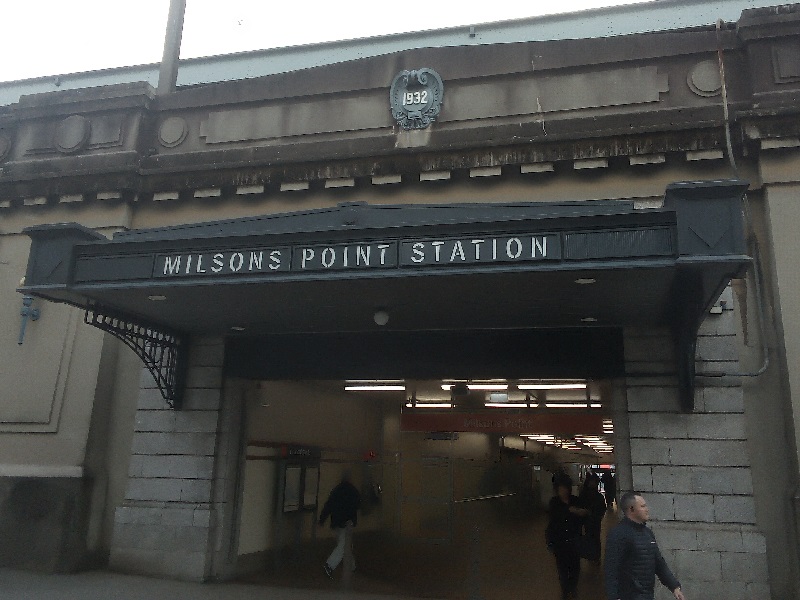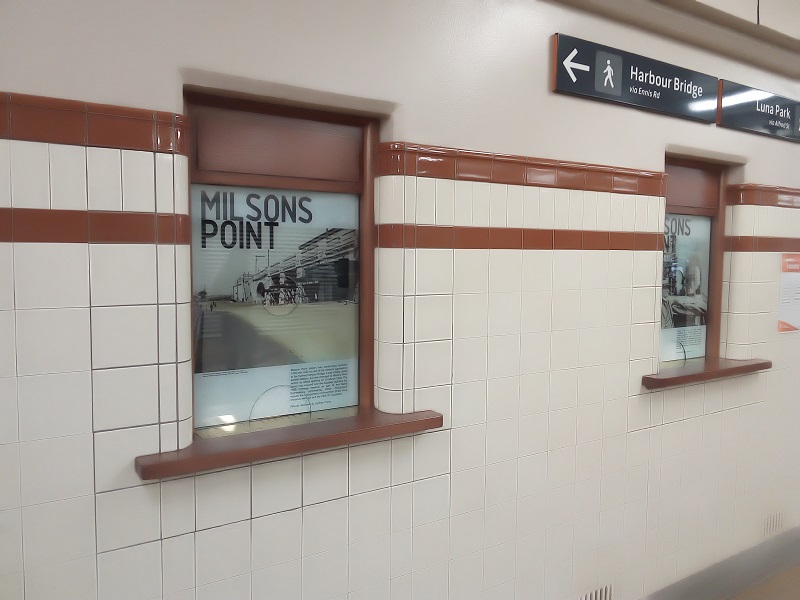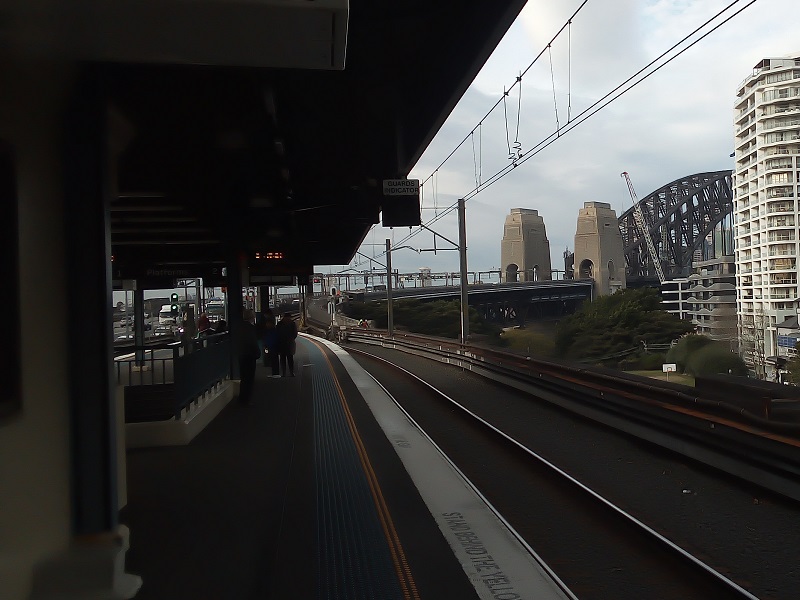One of the things about the world of a hundred years ago that is very different to the world of now, is that almost to deliberately spite the geopolitical nastiness that would see 100 million people destroyed for no good reason at all, some people who were given the job of making and remaking the world had a perspective which outlived themselves. It very much helped that technologies just happened to come along within decades of each other and so people went from living in muck filled houses with cholera to living in houses with proper plumbing and electric light.
By the 1920s, people had lights and some electric appliances, and trains and trams that all moved because of electric power. For people who had previously lived in a world of coal fired muck, it must have been like an Electric Eden.
For the harbour city, watching the bridge rise up from nothing must have been amazing. Also watching as the city was scarred and then filled in in preparation for the bright electric underground, must have also been amazing. Immediately to the north of the Sydney Harbour Bridge is Milsons Point Railway Station; which either by design or by accident, has one of the most mundane amazing things in the world - the stairs which lead up to the platforms.
Yes, the Sydney Harbour Bridge is a piece of charismatic mega-infrastructure which along with the hideous looking Opera House, forms one of the most iconic panoramas in the world. Nothing needs to be said about that. However, the the stairs which lead up to the platforms at Milsons Point Railway Station are one of those 1% pieces of brilliance which help supercharge the world to 103%.
Before you get there though:
The first thing that you notice when you enter Milsons Point station is that this looks like it is a cousin of St James. That's a bit strange when you consider that there are no direct connections between the two stations. St James Station forms part of the City Circle; which means that trains on the outer circle head from Wynyard and turn right and trains on the inner circle turn left to head south and into Wynyard.
As previously discussed, the platforms at Wynyard were numbered 1 & 2 for the tram platforms and 3 & 4 for the train platforms on the upper level. I do not know if upon the opening of Milsons Point station, whether or not the numbering pattern was the same or not. If it was not, then it is strange that there would have been two Number 1 and 2 platforms. If it was the same, then the train platforms have been renumbered.
The booking hall and ticket offices, sit underneath the roadway and railway lines and can be accessed from both sides. This is common where you have either an elevated railway line or one that is effectively elevated as compared with its surrounds because it sits on top of its own earthworks.
In the booking hall the original Ticket Offices are still here, albeit permanently closed. I imagine that in 1932 that they would have been similarly appointed to the Ticket Offices at Central, with brasswork. The need for the Ticket Offices no longer exists, what with automatic ticket machines and Opal which is used at gates with passimiters and of buses and ferries.
I imagine that in 1932 that one would have been able to buy tickets for both the train and the tram from these windows. What I do not know though, is if tickets were intermodal. Before the days of Opal cards, except for Travelpass tickets which allowed people to buy a week's worth of travel at once, intermodal travel was definitely not a thing with electric passimiters. I do not know if a meatbag human would have had the authority to accept intermodal travel but I have no doubt that even the most mediocre of humans is a million times smarter than a machine.
I have no idea if these stairs were brilliantly made by design or by accident but whatever the case, these stairs are the greatest sets of stairs in the world. If you think that me waxing lyrical about a set of stairs of all things is daft, then you'd be right. Then again, as someone who lives in a built environment, I find the ease of use of the infrastructure in that built environment pleasing.
A set of stairs basically only as two characteristics - rise and run. The rise of the stairs is the height between each individual step and the run is the length of the flat bit that your foot falls upon. If stairs have a rise which is too much, then each step is a lot of work. If stairs have a run which is too short, then you have to be careful about where you put your feet. This is why a significantly bigger than zero number of stairwells in Victorian-era houses are the site of servants (mainly women) being scalded because of carrying great pans of boiling water up stairs which were too steep and where the run was too short.
This is why these stairs are the greatest stairs in the world. These stairs have a rise which is very obviously not zero but the rise is both gentle and steep enough to still be functional. They also have a run which is big enough to accommodate a size 14 boot very pleasantly. Together, the rise and run of these stairs means that you can almost sprint up the them if you are late for a train. What's more amazing is that you can also almost sprint down these stairs, which is mostly unheard of.
What I also find intriguing about these stairs, is that they are dressed in the same tile design and broad tilework attire as Museum, St James, the hidden portions of Wynyard and the remaining bits of Town Hall. Central suffers from its 1988 refit at the Devonshire Street rail tunnel, Wynyard and Town Hall retain memories of what once was. St James and Museum look probably pretty close to how they did on opening day in 1926. Milsons Point station was opened along with the Harbour Bridge in 1932 and the fitting out and dressing of the station started from 1929 onwards. This leads me to believe that on opening day, it probably had roundels similar to St James, Museum, Town Hall and Wynyard, and the tilework would indicate to me that they were likely in red or brown.
Once you have run up the stairs, then you emerge at platform level which is the equivalent of the fifth story of buildings further on down the road. The Sydney Harbour Bridge is truly majestic because it is massively massive. I am used to travelling across the Bridge; so that means that on many occasions I do not notice it at all. The best journey that one can take is the most boring because when things just work, we do not have to.
Again, the Bridge is its own party piece and so I do not need to write very much about it here. However, I suspect that whatever invention was placed between Milsons Point and Dawes Point, that Milsons Point Railway Station would have still been excellent. This brings me back to my central point.
The greatest stairs in the world whether by accident or by design, only exist because someone had the forethought to build not only them in that way, but build the whole project. I really like the ramps at Strathfield Station because you can absolutely pelt up and down those like a mad thing. I really like the quiet serenity at Museum Station because even in the middle of a boisterous and bustling metropolis, one can still find quiet enjoyment in the melancholy and sadness of the calm. I really like the escalators, the neon barrel tile work, and the garishness of Kings Cross Station because those things work well with the chaos above. Some time soon, we shall see the opening of Central Walk and the Sydney Metro extension.
All of these things prove that we can build things that are lovely and grand, and that these things are best built in commonwealth as there is no way in nine circles of hell that private enterprise either has the capacity or care to do so.
Even so, these are the greatest stairs in the world and the millions of people who pass through here every year, do not really care because they have no need to. When things work excellently, we do not have to worry.





No comments:
Post a Comment